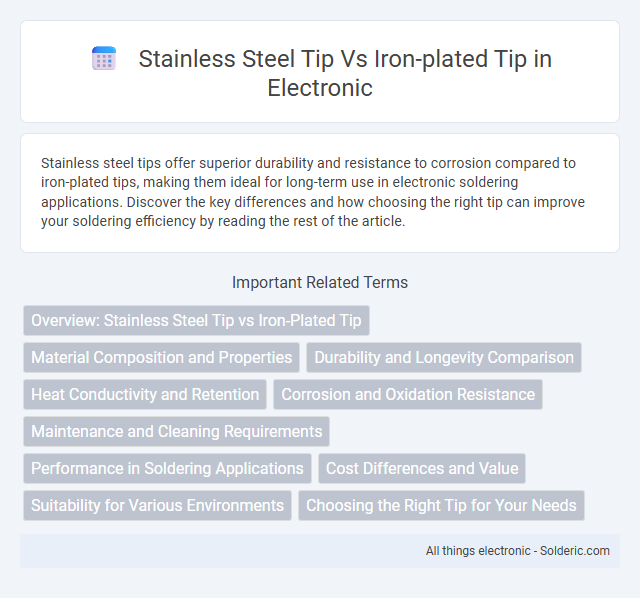Stainless steel tips offer superior durability and resistance to corrosion compared to iron-plated tips, making them ideal for long-term use in electronic soldering applications. Discover the key differences and how choosing the right tip can improve your soldering efficiency by reading the rest of the article.
Comparison Table
| Feature | Stainless Steel Tip | Iron-Plated Tip |
|---|---|---|
| Durability | Highly durable, corrosion-resistant | Moderate durability, prone to rust |
| Heat Conductivity | Good heat conductivity | Excellent heat conductivity |
| Maintenance | Low maintenance, easy to clean | Requires regular cleaning to prevent oxidation |
| Cost | Higher cost | More affordable |
| Usage | Ideal for long-term use, precise work | Suitable for budget-friendly, general purpose |
Overview: Stainless Steel Tip vs Iron-Plated Tip
Stainless steel tips offer superior corrosion resistance and durability, making them ideal for long-term use in various soldering tasks. Iron-plated tips feature a copper core coated with a thin layer of iron, providing excellent heat transfer but requiring more maintenance to prevent wear and oxidation. Choosing between stainless steel and iron-plated tips depends on your soldering frequency and the level of performance you need for precise, reliable results.
Material Composition and Properties
Stainless steel tips consist primarily of iron alloyed with chromium and nickel, providing excellent corrosion resistance and durability ideal for long-term use. Iron-plated tips feature a core of iron coated with a thin layer of iron plating, offering good conductivity but lower resistance to oxidation and wear compared to stainless steel. Your choice depends on the balance you need between corrosion resistance and thermal performance for specific applications.
Durability and Longevity Comparison
Stainless steel tips exhibit superior durability and corrosion resistance compared to iron-plated tips, making them ideal for long-term use in soldering and precision applications. Iron-plated tips, while initially cost-effective, tend to wear down faster due to the plating's susceptibility to chipping and oxidation under high temperatures. The inherent strength and oxidation resistance of stainless steel result in extended tip longevity, reducing replacement frequency and maintenance effort.
Heat Conductivity and Retention
Stainless steel tips exhibit lower heat conductivity compared to iron-plated tips, resulting in slower heat transfer and more controlled temperature maintenance during use. Iron-plated tips, known for their superior thermal conductivity, heat up quickly but can also lose heat faster when removed from the heat source. Stainless steel's enhanced heat retention capacity makes it ideal for sustained, even heating, while iron-plated tips offer rapid responsiveness but less consistent thermal stability over time.
Corrosion and Oxidation Resistance
Stainless steel tips offer superior corrosion and oxidation resistance due to their chromium content, which forms a protective oxide layer that prevents rust and degradation over time. Iron-plated tips, while more affordable, are prone to rust and oxidation, especially when exposed to moisture or high temperatures during soldering tasks. Choosing a stainless steel tip ensures longer durability and consistent performance for your soldering projects.
Maintenance and Cleaning Requirements
Stainless steel tips require minimal maintenance due to their resistance to rust and corrosion, making them easy to clean with just a damp cloth or mild cleaner. Iron-plated tips, however, demand more frequent cleaning to prevent oxidation and rust buildup, often needing special rust-removal products and careful drying after use. Regular maintenance of iron-plated tips is crucial to maintain performance and prolong their lifespan compared to the lower upkeep required for stainless steel tips.
Performance in Soldering Applications
Stainless steel tips offer superior durability and corrosion resistance, making them ideal for soldering applications that require long-lasting precision and consistent heat transfer. Iron-plated tips, while providing excellent thermal conductivity and faster heat-up times, tend to wear out quicker due to oxidation and erosion during prolonged use. Your choice depends on whether you prioritize tip longevity and maintenance or rapid heat response for short-term soldering tasks.
Cost Differences and Value
Stainless steel tips generally have a higher upfront cost compared to iron-plated tips due to their enhanced durability and resistance to corrosion. Iron-plated tips offer a budget-friendly option but tend to wear out faster, leading to more frequent replacements that can increase long-term expenses. Investing in stainless steel tips provides better value through longevity and consistent performance, reducing the overall cost of maintenance.
Suitability for Various Environments
Stainless steel tips offer superior corrosion resistance and durability, making them ideal for use in humid, outdoor, and industrial environments where exposure to moisture and chemicals is common. Iron-plated tips provide excellent heat conductivity and are well-suited for controlled indoor settings but may corrode faster in wet or corrosive conditions. Choosing between stainless steel and iron-plated tips depends on the environmental demands, with stainless steel preferred for longevity and resistance, and iron-plated tips favored for cost-effective, short-term applications.
Choosing the Right Tip for Your Needs
Stainless steel tips offer superior durability and corrosion resistance, making them ideal for long-term soldering projects requiring consistent performance in high-temperature environments. Iron-plated tips provide a cost-effective solution with excellent wetting properties, suitable for occasional or hobbyist use where precision and heat transfer efficiency are essential. Selecting the right tip depends on balancing budget, frequency of use, and the specific demands of the electronic components being soldered.
Stainless steel tip vs iron-plated tip Infographic

 solderic.com
solderic.com